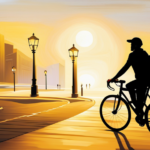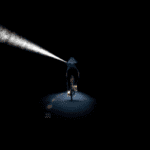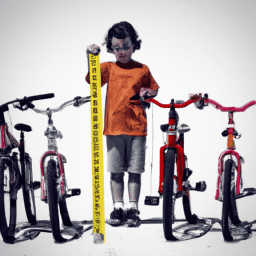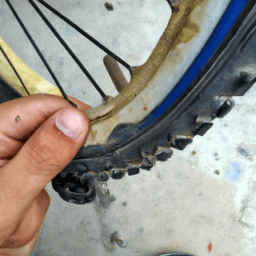Opting to cycle during nighttime requires a strict adherence to safety measures. It offers a thrilling adventure, yet it is fraught with hazards due to diminished visibility, making it challenging for motorists to notice you. Nonetheless, by equipping yourself with the right gear and adhering to a few basic guidelines, you can ensure a secure and pleasant cycling experience.
The first thing you should do is wear reflective clothing or accessories. This will help drivers see you from a distance and avoid accidents. Reflective clothing can be anything from vests, jackets, or even stickers on your bike. Adding reflective tape to your pedals, wheels, and handlebars can also increase your visibility.
Additionally, you should use lights on your bike to make sure drivers can see you, especially if you’re riding on a road without streetlights. Following these safety tips will ensure you have a safer and more enjoyable ride when cycling at night.
Key Takeaways
- Wear reflective clothing or accessories and use lights on your bike to enhance visibility.
- Choose appropriate routes to ride on at night and observe traffic rules.
- Regularly check tire pressure, oil the chain, and perform regular maintenance to ensure optimal performance and safety.
- More reflective material strategically placed on your body means better visibility.
Wear Reflective Clothing or Accessories
Don’t forget to wear some reflective gear to make yourself visible to others on the road! Reflective gear benefits you in two ways: first, it helps motorists notice you from a greater distance, giving them more time to react and avoid accidents.
Second, reflective gear helps you stand out from the surroundings, making it easier for you to navigate your way and stay on course.
When choosing reflective clothing, keep in mind that the more reflective material you have on your body, the better your visibility will be. Choose clothing made of reflective material, and ensure that the reflective material is strategically placed in areas where it will be most visible to motorists.
You can also add reflective accessories like armbands, leg bands, or vests to increase your visibility.
Remember, reflective gear is not just for your safety, but also for the safety of others on the road. With reflective clothing, you can ride more confidently knowing that you are doing your part to stay safe.
To further increase your visibility, use lights on your bike.
Use Lights on Your Bike
To ensure you’re visible on the road, make sure you’re using lights on your bike – it’s a crucial safety measure. The importance of visibility can’t be overstated when riding at night, and bike lights are an essential tool to achieve this.
Here are some different types of bike lights you can use to enhance your visibility:
-
Headlights: These are the most important lights to have on your bike when riding at night. They illuminate the road ahead of you, making it easier to see obstacles and potential hazards. There are different types of headlights available, including rechargeable and battery-powered options.
-
Rear Lights: Rear lights are mounted on the back of your bike and are used to make you visible to other road users from behind. They come in different shapes and sizes, and some even have built-in features such as turn signals.
-
Wheel Lights: These lights are mounted on the wheel spokes and create a stunning visual effect as the wheel spins. They can also increase your visibility to other road users.
By using bike lights, you’re not only increasing your visibility but also ensuring your safety. Remember to always check your lights before heading out and keep them charged or replace the batteries regularly.
Now that you know about the importance of visibility and different types of bike lights, let’s move on to the next step – choosing appropriate routes to ride on at night.
Choose Appropriate Routes
When planning your route for evening rides, it’s important to consider factors such as traffic volume and lighting in order to ensure a safe and enjoyable experience. Find well-lit areas to ride through, and avoid construction sites or areas with limited visibility. It’s also important to be aware of any potential hazards on your route, such as potholes or uneven pavement. To help you plan your route, use the table below to assess the safety of potential routes and choose the best one for your needs.
| Route | Traffic Volume | Lighting |
|---|---|---|
| A | Low | Good |
| B | High | Poor |
| C | Medium | Excellent |
By choosing a well-lit route with low traffic volume, you can minimize your risk of accidents and enjoy a smooth ride. However, it’s important to remember that even the safest route can still be dangerous if you don’t observe traffic rules. Always be alert and aware of your surroundings, and follow all traffic laws to ensure a safe and enjoyable ride.
Observe Traffic Rules
Observing traffic rules is like following a map that guides you towards a safe and smooth journey on your evening ride. When riding a bicycle at night, it’s crucial to follow traffic signals, including stop signs and traffic lights.
These signals are in place to protect both you and other road users. Remember to stop at stop signs, look both ways before proceeding, and never run a red light.
Additionally, staying alert is essential for a safe ride. Keep your eyes peeled for vehicles, pedestrians, and other hazards that may be on the road. Be aware of your surroundings and make sure to signal when turning or changing lanes.
By following traffic rules and staying alert, you can reduce the risk of accidents and enjoy a safer ride.
Now, let’s move on to the next section and talk about how to maintain your bike.
Maintain Your Bike
Maintaining your bike is essential for a smooth and safe ride, but have you ever wondered how often you should check your tire pressure and oil your chain? Regular maintenance is key to ensuring your bicycle is in top condition. It not only extends the lifespan of your bike, but it also guarantees that it is safe to ride.
To make sure your bike is in good working order, you should regularly check the tire pressure and oil your chain. Tire pressure affects how your bike handles and how much effort you need to put into pedaling. On the other hand, a well-oiled chain ensures that your bike shifts gears smoothly and efficiently. Proper storage is also crucial. When not in use, store your bike in a dry and cool place to prevent rust and other damage. By taking care of your bike, you can enjoy a safe and comfortable ride every time.
| Maintenance Tasks | How Often to Do Them |
|---|---|
| Check Tire Pressure | Once a week |
| Oil Chain | Every 200 miles |
| Grease Bearings | Every 500 miles |
| Replace Brake Pads | Every 1,000 miles |
Remember, the key to a safe and enjoyable ride is regular maintenance. By keeping your bike in top condition, you can avoid accidents and prolong its lifespan. So, make sure to check your tire pressure, oil your chain, and store your bike properly. And don’t forget to follow traffic rules when riding at night!
Frequently Asked Questions
What are the best types of reflective clothing or accessories to wear when riding a bicycle at night?
To enhance visibility at night, choose reflective clothing or accessories. Reflective tape is a cost-effective option to attach to your bike or clothing. High visibility gear is available online or at local bike shops.
How bright should the lights on my bike be for maximum visibility at night?
For maximum visibility at night, consider light angle and battery life when choosing bike lights. Weather can impact visibility, so brighter lights may be necessary in rain or fog. Illuminate your path and stay safe.
Are there any specific routes that are safer or more appropriate for riding a bicycle at night?
For nighttime bicycle safety, consider route options with well-lit and low-traffic roads. Increase visibility by wearing reflective clothing and using bright bike lights. Avoid distractions and stay alert to potential hazards.
Can I ride my bike on the sidewalk at night, or do I need to stay in the street?
When riding your bike on the sidewalk at night, remember riding etiquette and legal guidelines. It’s like driving a car on the sidewalk; it’s not safe for you or pedestrians. Stay in the street, wear reflective gear, and use lights to stay visible.
How often should I check and maintain my bike to ensure it is safe for riding at night?
Regular maintenance is crucial for safe nighttime riding. Check brakes, tires, lights, and reflectors before each ride. Look for loose bolts, worn parts, or frayed cables. Replace or repair any issues immediately. Stay visible and stay safe.
Conclusion
In conclusion, when riding a bicycle at night, it’s crucial to take safety precautions to avoid accidents. Remember to wear reflective clothing or accessories, use lights on your bike, choose appropriate routes, observe traffic rules, and maintain your bike. These measures will not only protect you but also help you become visible to drivers and other road users.
According to the National Highway Traffic Safety Administration (NHTSA), bicyclist fatalities occur most often between 6 pm and 9 pm and are more common in urban areas. In 2019, 846 bicyclists were killed in traffic crashes in the United States, and 69% of them occurred in urban areas. This means that it’s even more important to be aware of your surroundings and adhere to the safety measures mentioned above when cycling at night in cities.
Always remember that your safety is paramount, and taking the necessary precautions will help you avoid accidents and enjoy your ride. Don’t let darkness deter you from cycling; just ensure that you’re well-prepared and equipped to handle any situation that may arise.
















